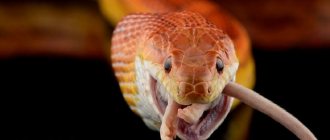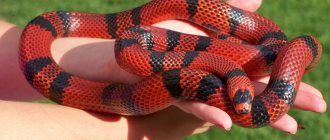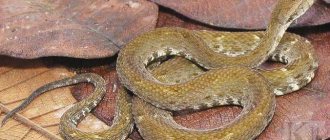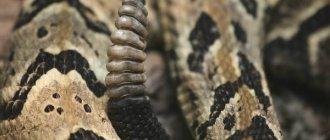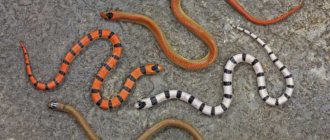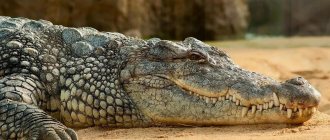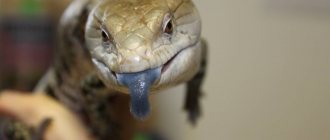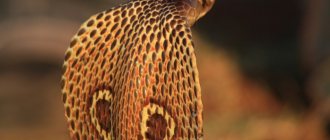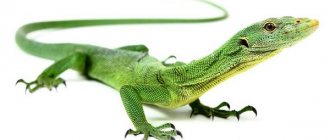- Exotic pets
| Data left by users (City, cost) | |
| Malarita | From10 to 20 |
Today, more than three thousand species of snakes are well known and studied, which are grouped into several families and superfamilies. Of these, about a quarter are represented by poisonous species. A limited number of species are suitable for keeping at home. Exotic pets attract attention with their composure and calmness. Many species are not only unpretentious, but also quite easy to tame.
Zoologists have discovered a snake that feeds exclusively on plant foods and is common in Mexico. Its peculiarity is its fluffy body and calm disposition, thanks to which this snake is popular among Mexicans as a pet.
When choosing, be sure to familiarize yourself with the character and behavior of the snake, the average size of an adult, take into account the grip strength and toxicity indicators, and also find out the food preferences of the species.
Snake as a pet
The Snake suborder, consisting of 2,500 species, is not a warm-blooded creature. Body length is from 0.1 to 9 m, but most of these animals are 1 m. The shape is short and thick, long, thin, flattened. Representatives of all species have dry skin with dense scales. On its belly it is adapted for crawling. The colors vary - from simple dark colors to bright ones, with multi-colored spots or stripes; in others, they form fancy patterns. Twice a year, individuals shed their old cover, under which a new, initially vulnerable, cover has grown. Healthy reptiles shed within 20 minutes.
Low-blind and hard of hearing, snakes feel objects and recognize odors with their tongue. They sense heat perfectly with the organ located between the eyes. The eyes are a special part of the animal’s body: they never close, are always covered with fused transparent eyelids, and frighten with an unblinking gaze. The food of predators consists mainly of rodents, small birds and their eggs, frogs, lizards, and sometimes insects and worms. The food is swallowed whole, head first, having previously been rendered harmless by squeezing or poison. Prey is digested on average in 2-8 days, the warmer it is, the faster.
The best choice for a beginner would be a non-venomous animal. Poisonous animals are prohibited for keeping at home. The most harmless are small domestic snakes up to 1.5 m long.
The most popular types of domestic snakes:
- The Red Rat Snake is very easy to care for and is active and curious. Easily tamed and child friendly. The Corn Snake has beautiful patterns of different colors on its body. An interesting snake, agile, calmly walking into your arms.
Green python
These green snakes are of great interest to many reptile lovers. Green pythons, which live in trees, like to curl up into an elegant ring and hang from a tree, especially on small branches. These are very bright green (sometimes yellow) giant snakes, their length is about 7 meters. Because of this, they often become entangled in the branches of the tree on which they live.
Character and behavior of snakes
Snakes defend themselves by frightening by hissing, moving their tail, imitating the color of a poisonous snake, and can emit an unpleasant odor or pretend to be dead. They can climb trees, swim well, and crawl on land at a speed of 3-15 km/h. Many are active during the day, and there are nocturnal predators. Some hunt, crawling silently, others “scour” the territory and pounce. The amount of food eaten is much less than the weight of the snake. A low metabolic rate allows her to endure hunger for several months. They live alone, as they are prone to cannibalism.
The snake as a pet is quite calm. Even if you anger an animal, it will simply try to hide or hiss, otherwise it will defend itself by pinching the offender. At home, they only allow you to take care of themselves, they get used to the smells of a person, but they are not able to love him. Before hibernation or before molting, a previously active animal may refuse food and lie indifferently in a ring. While walking around the house, the pet can escape through a suitable gap.
What should a terrarium be like?
The terrarium can be made of plastic or glass, the main thing is that it has ventilation and does not give the animal the opportunity to leave the designated area without permission. For reptiles, habitat zones with different temperatures (warm and cooler) are important, so it is desirable that there is a temperature gradient in the terrarium. For example, at the top you can make a platform with a lamp for the reptile to warm up, and at the bottom of the terrarium there is a cold zone. For tropical animals, a comfortable temperature will be 28-35 °C, for residents of subtropical latitudes - 24-30 °C.
Is it possible to keep a lynx at home? More details
Nutrition of domestic snakes
Snakes have a physiological need for live food. Moreover, keeping a reptile that prefers a particular food is always difficult. Owners often wonder what to feed their snake at home. You can switch to killed rodents or birds, but not all pets eat this. One whole victim is enough for feeding. Experts say that a snake, as a pet, should not eat live food to avoid becoming infected or injured. You can buy frozen food. But in such a product, many beneficial substances are destroyed, without which the pet’s immunity is greatly weakened.
It is better to feed a newly acquired snake for 4-5 days. Adult animals eat once a week, small ones - every 5 days. Meter-sized individuals are fed once every 2 weeks or 30 days. While shedding their skin and in hibernation, they go without food for 2-4 months. The carcass should be 2 times thicker than the widest part of the snake’s body, the size of its head. For safety, rats' incisors are broken or stunned. After eating, to prevent the snake from regurgitating, you do not need to touch the animal for 3 days.
Blood Python
Known to be a particularly temperamental species. The blood python is a stocky snake with beautiful patterns. They have short tails and can grow up to 8 meters in length. Pythons get their name from the brick-red spots that can often be seen on their body.
How to grow strong tomato seedlings with the right fertilizer?
“Creative thinking”: Rosobrnadzor assessed the possibility of transforming the Unified State Exam
The strawberry harvest will increase many times: we water the bushes in the spring with garlic fertilizer
Maintenance and care
Keeping snakes at home requires compliance with certain rules.
Requirements for the terrarium:
- Material: glass or plastic.
- Dimensions for medium animals are length 80, width and height 55, for large animals – 110 and 60 cm.
- Fluorescent lighting.
- Heating for snakes in the middle zone is 25-30 degrees Celsius during the day, and for tropical ones - up to 35. At night it is 5 degrees cooler.
- Good locks on the door.
- Correct electrical wiring.
- Providing shelter: roots, branches, stones, caves.
- Suitable bedding made from special sawdust, but not from coniferous trees; coconut flakes; You can take a napkin or diaper.
- One half of the snake’s house should be dry and warm, the other half should be cool and humid.
- A prerequisite is a drinking bowl (pool).
Purity:
- change the water in the drinking bowl every day;
- monthly major cleaning with replacement of soil and shelter fragments as necessary;
- washing the pool when dirt appears in it;
- After each meal, remove drops and crumbs;
- disinfect with UHF, the rays of which have a beneficial effect on snakes and destroy ticks.
The air should be 90% humid, which will be helped by spraying twice.
You should handle your pet carefully. You need to tame it after the snake gets used to the smell of its owner. You should not make sudden movements; it is more correct to hold it from the sides so that the body lies on your arms. If the animal shows concern, release it back to its place.
Already
The length can vary greatly - the range is as follows: 0.15-3.5 m. Coloring too. Moreover, it can be either plain or with dark spots. Snakes are not poisonous.
In conclusion, we note that the white snake symbolizes prophetic power and wisdom.
Our ancestors believed that whoever tried its meat acquired knowledge of the language of birds and animals, and the most hidden treasures were revealed to him.
Of course, these are all stories. However, if you keep snakes at home, such a specimen will definitely not be superfluous.
Subtleties and nuances when keeping snakes at home
- The new terrarium, with heating connected, warms up within three days.
- A mouse that is not eaten and left with a snake in its house can attack the reptile and bite.
- Frozen food should be warmed (not in the microwave) to room temperature.
- Food should be dried or wiped dry.
- It is better to feed using a separate box.
- Use dietary supplements and liquid vitamins.
- Do not touch your pet if your hands are not washed after feeding.
- It happens that snakes kept at home have difficulty shedding their skin sheath. In this case, they need help.
- After 2-4 years, individuals become sexually mature, at which time growth is fastest.
- The embryos develop within 1-2 months in the laid eggs.
Texas snake
Another name for this reptile is the white rat snake.
This name is explained not only by its diet, but also by its external similarity. This is a rather rare species. It is not poisonous. But its bites are quite painful.
It is also worth noting the pronounced aggressiveness when changing the skin or in the presence of a threat. Snakes live up to 17 years.
Tips for keeping snakes
When choosing a pet, you need to find out in advance about its taste preferences. It is better to purchase a snake from a reliable, trusted place. It is highly undesirable to choose dangerous representatives of the species. You need to purchase everything you need in advance and study how to keep snakes at home.
The future pet should be checked by picking it up to see how strong and well-nourished the body is, and whether there are ticks. At home, place the reptile in a place away from other snakes and do not disturb it for 3-4 days. You must not bathe the snake, approach it with your face, and do not let other domestic animals near it. If she is very dirty, then let her swim in the bath and wash the baby under warm water.
Feeding in captivity
In nature, the Sinaloyan milk snake feeds on large insects, lizards, small rodents, and other snakes.
In captivity, the diet of these snakes may well be made up of specially bred ones! rodents and insects. You need to feed your milk snake no more than once every five days.
Along with the food, it is necessary to add special vitamins and mineral supplements, according to the manufacturer's instructions. Crushed chicken egg shells can be an additional source of calcium. Minerals can also be added to the water your snake drinks regularly.
Health and lifespan of kites
Domesticated snakes are susceptible to diseases that are easier to prevent than to treat. In addition, they need regular examination by a veterinarian. The causes of diseases may include improper feeding, maintenance, and stress. If there are any deviations in the pet’s behavior from the norm, it should be shown to a specialist. How long do pet snakes live? Scientists suggest that age depends on the length of the individual. With good care at home, some live 40 years or more. The average life of a domestic snake is 10-20 years.
A kind and calm, cunning and smart, beautiful and bewitching inhabitant of the terrarium can really become a friend for many years. And the maintenance of her home will be a thoughtful and original decoration of the room.
Dark tiger python
These are large snakes, but still many choose them as a pet. They grow up to 15-20 meters in length (and sometimes more). Birmans (as they are also called) are usually quite docile, but are more active than the small ball python.
Alexandra Shoua's eldest daughter grew up without him, but forgave him all his insults
Why hysteria is a stage of development, and how to help your child survive it
Nature generously endowed Ossetians with magical beauty: photo
These big guys need to be fed big dead rats or other larger prey. Due to their heavy weight, these pythons are best suited for responsible adult owners.
Western Gognoz
- Size: 14 inches to 3 feet (women are larger)
- Availability: general
- Temperament: Docile. Engaged in harmless bluffing.
- Feeding Response: Excellent
Not only are these snakes unique in appearance, with their robust body and upturned snout, but they also have interesting behavior. These animals have impressive bluffing behavior when they feel threatened; they hiss, flatten their body, and may even appear dead, like the last effort of a ditch. However, captive-bred snakes rarely feel the need to put on these protective displays due to their laid-back nature. They also rarely bite, and self-confident snakes that are defensive will even strike their opponents with their mouths closed. These snakes may also secrete a smelly musk in defense. These snakes are easy to care for and can be kept in a small, inexpensive enclosure (20 liter tank or plastic container), however they do require additional lighting.
